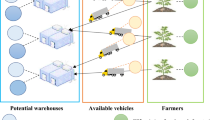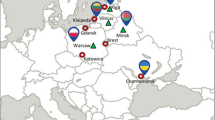Abstract
In the present work, a bi-objective optimization model is proposed for the green management of the supply chain of fresh fruit considering transportation costs, and environmental impact categories given by the ReCiPe methodology. The ε-constraint method is used to convert the bi-objective function into a single-objective optimization problem and it is applied to two case studies to test the model in a tomato supply chain, providing a set of Pareto solutions. Results showed that the most affected environmental impact category is “climate change” from the emission of greenhouse gases and that there are greater CO2 emissions at the stage of transportation from producers to warehouses. Solutions obtained by the proposed approach provided useful information such as the best operating points for the green management of the supply chain. Moreover, the model can be used in similar situations for regional development.







Similar content being viewed by others
Abbreviations
- BPO:
-
Best practical option
- C1:
-
Scenario 1
- C2:
-
Scenario 2
- f N :
-
Nadir point
- f U :
-
Utopia point
- GHG:
-
Greenhouse gases
- GSCM:
-
Green supply chain management
- LCA:
-
Life cycle assessment
- LCIA:
-
Life cycle impact assessment
- LP:
-
Linear programming
- MK k :
-
Supermarket k
- MILP:
-
Mixed integer linear programming
- MOO:
-
Multi-objective optimization
- NMVOC:
-
Non-methane volatile organic compounds
- Pi :
-
Producer i
- SC:
-
Supply chain
- SCM:
-
Supply chain management
- W j :
-
Warehouse j
- F :
-
Multiobjective function
- f 1 :
-
Economic function
- f 2 :
-
Environmental function
- i :
-
Index of producer i
- j :
-
Index of warehouse j
- k :
-
Index of supermarket k
- b i :
-
Minimum amount must deliver
- ca jk :
-
Transportation cost from warehouse j to supermarket k
- cp ij :
-
Transportation cost from producer i to warehouse j
- dm k :
-
Supermarket k total demand
- da j :
-
Warehouse j demand
- ecoPW ij :
-
Impact (kg) from producer i to warehouse j
- ecoW jk :
-
Impact (kg) from warehouse j to supermarket k
- sa j :
-
Quantities offered by the warehouse
- sp i :
-
Producer i production capacity
- tp ij :
-
Distance from producer i to warehouse j
- tw jk :
-
Distance from warehouse j to supermarket k
- ε :
-
Épsilon for constrained objective functions
- x 1ij :
-
Total distributed from producer i to warehouse j
- x 2jk :
-
Total distributed from warehouse j to supermarket k
- M1:
-
Agricultural land occupation (m2a)
- M2:
-
Climate change (kg CO2-eq)
- M3:
-
Fossil depletion (kg oil-eq)
- M4:
-
Freshwater ecotoxicity (kg 1,4-DC)
- M5:
-
Freshwater eutrophication (kg 1,4-DC)
- M6:
-
Human toxicity (kg 1,4-DC)
- M7:
-
Ionising radiation (kg U235-eq)
- M8:
-
Marine ecotoxicity (kg 1,4-DC)
- M9:
-
Marine eutrophication (kg N-eq)
- M10:
-
Metal depletion (kg Fe-eq)
- M11:
-
Natural land transformation (m2a)
- M12:
-
Ozone depletion (kg CFC-11)
- M13:
-
Particulate matter (kg PM10-eq)
- M14:
-
Photochemical oxidant (kg NMVOC)
- M15:
-
Terrestrial acidification (kg SO2-eq)
- M16:
-
Terrestrial ecotoxicity (kg 1,4-DC)
- M17:
-
Urban land occupation (m2a)
References
Azapagic A, Clift R (1998) Linear programming as a tool in life cycle assessment. Int J Life Cycle Assess 3(6):305–316
Bare JC, Hofstetter P, Pennington DW, Udo de Haes HA (2000) Midpoints versus endpoints: the sacrifices and benefits. Int J Life Cycle Assess 5:319–326
Bauer PE, Maciel Filho R (2004) Incorporation of environmental impact criteria in the design and operation of chemical processes. Braz J Chem Eng 21:405–414
Brandenburg M, Govindan K, Sarkis J, Seuring S (2013) Quantitative models for sustainable supply chain management: developments and directions. Eur J Oper Res 233:299–312
Camilo R, Mano TB, Rocha LB, Almeida RA, Rezende RVP, Ravagnani MASS (2017) Sustainable of tomatoes supply chain management—cases of study. In: 6th international workshop advances in cleaner production: ten years working together for a sustainable future, São Paulo
Carreras J, Pozo C, Boer D, Guillén-Gosálbez G, Caballero JA, Ruiz-Femenia R, Jiménez L (2016) Systematic approach for the life cycle multi-objective optimization of buildings combining objective reduction and surrogate modeling. Energy Build 130:506–518
Chang MA (2014) Scenario-based mixed integer linear programming model for composite power system expansion planning with greenhouse gas emission controls. Clean Technol Environ Policy 16:1001–1014
Clift R (2003) Metrics for supply chain sustainability. Clean Technol Environ Policy 5:240–247
D’Amore F, Bezzo F (2017) Economic optimisation of European supply chains for CO2 capture, transport and sequestration. Int J Greenh Gas Control 65:99–116
De Feo G, Forni M, Petito F, Renno C (2016) Life cycle assessment and economic analysis of a low concentrating photovoltaic system. Environ Technol 37:2473–2482
De Silva TA, Forbes SL (2016) Sustainability in the New Zealand horticulture industry. J Clean Prod 112:2381–2391
Deb K, Gupta S (2011) Understanding knee points in bicriteria problems and their implications as preferred solution principles. Eng Optim 43:1175–1204
Ehrgott M, Ruzika S (2008) Improved ε-constraint method for multiobjective programming. J Optim Theory Appl 138:375–396
Eskandarpour M, Dejax P, Miemczyk J, Péton O (2015) Sustainable supply chain network design: an optimization-oriented review. Omega 54:11–32
Gomes P, Malheiros T, Fernandes V, Sobral MC (2016) Environmental indicators for sustainability: a strategic analysis for the sugarcane ethanol context in Brazil. Environ Technol 37:16–27
Guillén-gosálbez G, Caballero JA, Jiménez L (2008) Application of life cycle assessment to the structural optimization of process flowsheets. Ind Eng Chem Res 47:777–789c
Huijbregts MAJ, Steinmann ZJN, Elshout PMF, Stam G, Verones F, Vieira MDM, Hollander A, Zijp M, Van Zelm R (2016) A harmonized life cycle impact assessment method at midpoint and endpoint level. Report I: characterization, Bilthoven
Islam S, Ponnambalam SG, Lam HL (2017) A novel framework for analyzing the green value of food supply chain based on life cycle assessment. Clean Technol Environ Policy 19:93–103
ISO 14040 (2006) Environmental management—life cycle assessment—principles and framework. International Organization for Standardization, Geneva
Khoshnevisan B, Rafiee S, Mousazadeh H (2013) Environmental impact assessment of open field and greenhouse strawberry production. Eur J Agron 50:29–37
Luo X, Hu J, Zhao J, Zhang B, Chen Y, Mo S (2014) Multi-objective optimization for the design and synthesis of utility systems with emission abatement technology concerns. Appl Energy 136:1110–1131
Mano TB, Guillén-Gosálbez G, Jiménez L, Ravagnani MASS (2019) Synthesis of heat exchanger networks with economic and environmental assessment using fuzzy—analytic hierarchy process. Chem Eng Sci 195:185–200
Mavrotas G (2009) Effective implementation of the ε-constraint method in multi-objective mathematical programming problems. Appl Math Comput 213:455–465
Monteiro JGMS, Silva PAC, Araújo OQF, Medeiros JL (2010) Pareto optimization of an industrial ecosystem: sustainability maximization. Braz J Chem Eng 27:429–440
Ortiz-Gutiérrez RA, Giarola S, Bezzo F (2013) Optimal design of ethanol supply chains considering carbon trading effects and multiple technologies for side-product exploitation. Environ Technol 34:2189–2199
Palomares-Rodríguez C, Martínez-Guido SI, Apolinar-Cortés J, Chávez-Parga MC, García-Castillo CC, Ponce-Ortega JM (2017) Environmental, technical, and economic evaluation of a new treatment for istewater from slaughterhouses. Int J Environ Res 11(4):535–545
QGIS (2015) Development Team—QGIS Geographic Information System. Open Source Geospatial Foundation. http://qgis.osgeo.org. Accessed 18 Feb 2019
Quaglia A, Sarup B, Sin G, Gani R (2012) Integrated business and engineering framework for synthesis and design of enterprise-wide processing networks. Comput Chem Eng 38:213–223
Rashidi J, Rhee G, Kim M, Nam K, Heo S, Yoo C, Karbassi A (2018) Life cycle and economic assessments of key emerging energy efficient wastewater treatment processes for climate change adaptation. Int J Environ Res 12:815–827
Robertson K, Garnham M, Symes W (2014) Life cycle carbon footprint of the packaging and transport of New Zealand kiwifruit. Int J Life Cycle Assess 19:1693–1704
Russell A, Ghalaieny M, Gazdiyeva B, Zhumabayeva S, Kurmanbayeva A, Akhmetov KK, Althonayan A (2018) A spatial survey of environmental indicators for Kazakhstan: an examination of current conditions and future needs. Int J Environ Res 12(5):735–748
Saer A, Lansing S, Davitt NH, Graves RE (2013) Life cycle assessment of a food waste composting system: environmental impact hotspots. J Clean Prod 52:234–244
Sales LDPA, Luna FMTD, Prata BDA (2018) An integrated optimization and simulation model for refinery planning including external loads and product evaluation. Braz J Chem Eng 35:199–215
SEAB (2016) Secretaria de Estado de Abastecimento (State Secretary of Supply), Olericultura—Análise do Conjuntura Agropecuária. Paraná, Brazil [in Portuguese]. http://www.agricultura.pr.gov.br/arquivos/File/deral/Prognosticos/2017/Olericultura_2015_16.pdf. Accessed 18 Feb 2019
Silva RO, Torres CM, Bonfim-Rocha L, Lima OCM, Coutu A, Jiménez L, Jorge LMM (2018) Multi-objective optimization of an industrial ethanol distillation system for vinasse reduction—a case study. J Clean Prod 183:956–963
Song J, Park H, Lee D, Park S (2002) Scheduling of actual size refinery processes considering environmental impacts with multiobjective optimization. Ind Eng Chem Res 41:4794–4806
Soode E, Lampert P, Weber-Blaschke G, Richter K (2015) Carbon footprints of the horticultural products strawberries, asparagus, roses and orchids in Germany. J Clean Prod 87:68–179
Spielmann M, Bauer C, Dones R, Tuchschmid M (2007) Transport Services. Ecoinvent report no. 14. Swiss Centre for Life Cycle Inventories, Dübendorf
Wolf M, Pant R, Chomkhamsri K, Sala S, Pennington D (2010) JRC Report on the International Reference Life Cycle Data System Handbook—EUR 24982—Joint Research Centre—Institute for Environment and Sustainability. Publications Office of the European Union, Luxembourg
Zhang Q, Shah N, Issick J, Helling R, Egerschot VP (2014) Sustainable supply chain optimization: an Industrial case of study. Comput Ind Eng 74:68–83
Acknowledgements
The authors are thankful for the financial support from Coordination for the Improvement of Higher Education Personnel—Process 88881.171419/2018-01—CAPES (Brazil) and the National Council for Scientific and Technological Development (Brazil).
Author information
Authors and Affiliations
Corresponding author
Ethics declarations
Conflict of interest
On behalf of all authors, the corresponding author states that there is no conflict of interest.
Additional information
Publisher's Note
Springer Nature remains neutral with regard to jurisdictional claims in published maps and institutional affiliations.
Appendices
Appendix A: State of art
See Table 4.
Appendix B: Pareto fronts obtained by optimizing the cost function and restricting to the impact categories M3, M6, M7, M10 and M17, respectively
The blue points comprise the Pareto Front, the green triangle represents the Utopia Point, the purple diamond indicates the Nadir Point, and the letter “x” shows the Knee Point.
Rights and permissions
About this article
Cite this article
Camilo, R., Bonfim-Rocha, L., Macowski, D.H. et al. Bi-objective optimization of a supply chain: identification of the key impact category and green management. Braz. J. Chem. Eng. 37, 157–171 (2020). https://doi.org/10.1007/s43153-020-00028-8
Received:
Revised:
Accepted:
Published:
Issue Date:
DOI: https://doi.org/10.1007/s43153-020-00028-8









